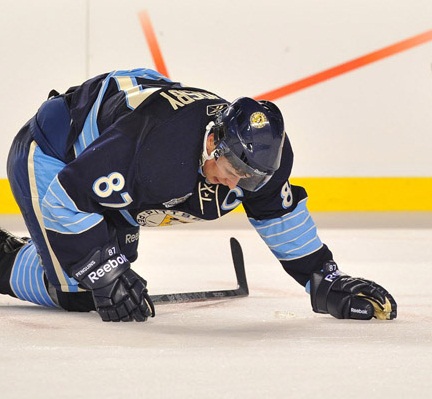Sidney Crosby’s concussion has been the cause of a bit of a stir within the hockey community. There has been an ongoing fear that Crosby, arguably the best player in the world, may be forced into an early retirement due to recurring symptoms from a concussion. Maybe on a larger scale, Crosby represents a larger problem in sports medicine in that a lot of athletes from different sports have suffered from longstanding concussion symptoms and there don’t appear to be easily identifiable solutions to these problems.

The Penguins recently posted a video from a press conference with Crosby and two of his doctors, Dr. Michael Collins and Dr. Ted Carrick, discussing his recovery process. The doctors do a great job of discussing his recovery and their approach to his rehabilitation.
Check out the video below:
One of the worst things a player can do is rush back too quickly. I picked up an alarming statistic from Dr. Josh Bloom at Pete Friesen’s Physio-Fitness Summit a couple years ago that 75% and 92% of repeat concussions occur within 7 and 10 days of the original incident, respectively. The recovery process and severity of symptoms tends to become increasingly worse with repeat incidences, which could be prevented with a more conservative return to play strategy. Understanding the nature of these repeat injuries has certainly been an instrumental part in prolonging the return to play recommendations. The doctors allude to the appropriate return to play process, but the general progression is:
In reality, most hockey players probably skip #1, half-ass #2, and then jump right to #7. Contrary to common practice, headaches are not supposed to be a normal part of the game, and the decision of whether or not a player is fit to play should never be left to the player, ESPECIALLY at the youth levels. Youth players simply don’t understand the severity if these injuries and will always err on the side of their competitiveness. It’s important that these injuries be taken seriously at ALL levels of play. The long-term implications can be severe and certainly warrant a more cautious approach than what has traditionally been taken. While no one would wish Crosby’s symptoms on anyone, I hope that his injury will bring an increased level of awareness to the severity of traumatic head injuries and that quality information will trickle down to youth, junior, college, and semi-pro levels where the quality of care may not be as thorough as what Crosby has access to.
To your health and success,
Kevin Neeld